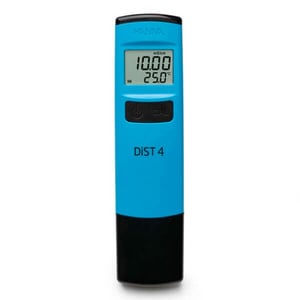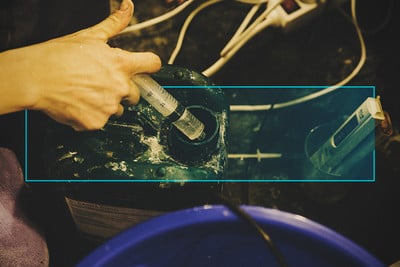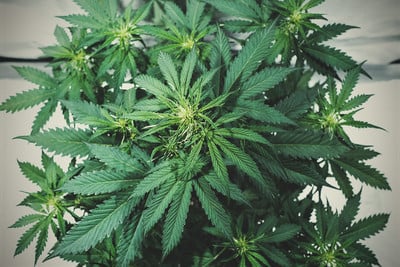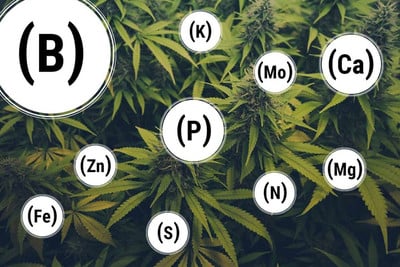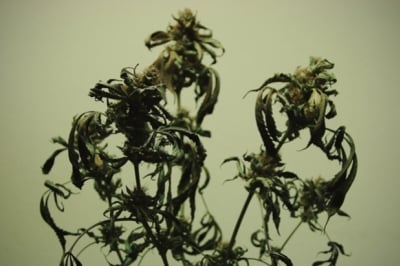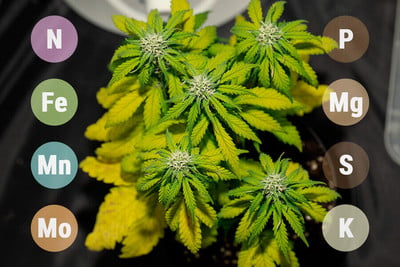Included FREE items

Nutrient Burn In Cannabis Plants
- Growing cannabis step by step
- Cannabis growing basics
- Choosing your seeds
- How to germinate seeds
- The cannabis vegetative stage
- The cannabis flowering stage
- Harvesting cannabis
- Trimming, drying, and curing
- Choosing pots and soil
-
Growing indoors
- A Complete Overview Of Growing Cannabis Indoors
- Cannabis Cultivation Tips: How To Set Up Indoor Grow Lights
- How Many Cannabis Plants Can You Grow Per Square Metre?
- Indoor Cannabis Growing: Relative Humidity and Temperatures
- Hydroponics Cannabis Growing Guide (with diagrams)
- Cannabis Micro Growing: Growing Great Weed in Tiny Spaces
- Growing outdoors
- How to grow autoflowering cannabis
- Cannabis nutrients and pH
- Cannabis troubleshooting: Nutrients
-
Cannabis troubleshooting: Growing
- Cannabis Seed Germination — Troubleshooting Guide
- How to Deal With Pythium (Root Rot) in Cannabis Plants
- Slow Cannabis Plant Growth And What You Can Do About It
- How to Prevent and Fix Stretching in Cannabis Seedlings
- Watering Your Cannabis: How To Fix Over And Underwatering
- Understanding Male, Female, And Hermaphrodite Cannabis
- Identifying and Treating Common Cannabis Ailments
- How To Revive a Sick Cannabis Plant
- How to Avoid Mouldy Weed During Drying and Curing
- How to Prevent and Treat Dry and Crispy Cannabis Leaves
- What Cannabis Leaves Can Tell You
- Yellow Cannabis Leaves
-
Cannabis Strains Grow Report
- HulkBerry Automatic Grow Report
- Blue Cheese Auto Grow Report
- Purple Punch Automatic Grow Report
- Triple G Automatic Grow Report
- Do-Si-Dos Automatic Grow Report
- Green Gelato Automatic Grow Report
- Haze Berry Automatic Grow Report
- Purple Queen Automatic Grow Report
- Cookies Gelato Automatic Grow Report
- Sherbet Queen Automatic Grow Report
- Sweet Skunk Automatic Grow Report
- Medusa F1 Grow Report
- Cannabis plant training
-
Weed growing tips
- The Cannabis Plant Anatomy
- How to preserve seeds
- How Much Sunlight Do Outdoor Cannabis Plants Need To Grow?
- How to Control and Prevent Stretching in Cannabis Plants
- How And When To Transplant Your Cannabis Plants
- My Cannabis Plants Are Growing Too Tall: What Should I Do?
- Should You Worry About Purple Or Red Cannabis Stems?
- What To Do When Your Indoor Cannabis Won’t Flower
- How To Protect Your Cannabis Plants From Heat Stress
- How To Tell If Your Female Cannabis Plant Has Been Pollinated
- Growing Medical Marijuana
- Bud Washing: How to Clean Your Weed
Contents:
Most people start growing cannabis with an idealistic vision. They imagine an easy, linear path from seed to harvest, without many hurdles involved. While there are much harder things to accomplish than growing weed, the hobby comes with a long list of challenges, including cannabis nutrient burn (also known as cannabis nute burn).
Fortunately, every challenge serves as a learning experience that will ultimately make you a better grower. Learn everything you need to know about nutrient burn below, including what causes it, how to identify it, and tips for prevention.
Cannabis Nutrient Burn
Nutrient burn in cannabis could be called the “novices lament” or “over-enthusiasm backlash”. Nutrient burn is a type of stress caused by overfeeding your plants or mixing nutrients too strongly. Novice growers are often under the misconception that more is better. This is very untrue. Often, burning can be caused by simple human error. Luckily, the condition can be fixed before it demolishes your crop. That said, it can damage a crop at any stage of its development.
Unlike animals (humans included), plants don't put on weight when you overfeed them. After all, plants are a whole different order of organism. They require a balanced and ongoing series of chemical reactions to survive and thrive. Trying to fatten them up with extra feeding is the fast track to disappointment.
There are several underlying factors that cause cannabis nutrient burn, including:
| Nutrient mix | Mixing nutrients stronger than recommended during any phase of growth |
| Overwatering | Plants need a dry period to function properly and access oxygen |
| Bloom boosters | Using bloom boosters too often or in too high a concentration |
| Growth stimulants | Using growth stimulants too regularly, causing dwarfism and burning due to excessive nutrient uptake |
| “Hot” growing medium | Excess nutrients in the growing medium can make it too rich (or “hot”). When quantities are too high, cannabis plants can’t handle it and nutrient burn sets in. Fresh manure or artificially nutrient-enriched soil are the usual culprits. |
| Dry soil | Letting your soil dry out too much can cause nutrient salts to build up. Suddenly watering the growing medium can cause the salts to mobilise all at once, resulting in a big uptake of nutrients and subsequent burning. |
| Low light | Cannabis plants need light to drive physiological processes and create energy. Poor levels can increase the chance of nutrient burn, even at low nutrient concentrations. |
| Nutrient mix | Mixing nutrients stronger than recommended during any phase of growth |
| Overwatering | Plants need a dry period to function properly and access oxygen |
| Bloom boosters | Using bloom boosters too often or in too high a concentration |
| Growth stimulants | Using growth stimulants too regularly, causing dwarfism and burning due to excessive nutrient uptake |
| “Hot” growing medium | Excess nutrients in the growing medium can make it too rich (or “hot”). When quantities are too high, cannabis plants can’t handle it and nutrient burn sets in. Fresh manure or artificially nutrient-enriched soil are the usual culprits. |
| Dry soil | Letting your soil dry out too much can cause nutrient salts to build up. Suddenly watering the growing medium can cause the salts to mobilise all at once, resulting in a big uptake of nutrients and subsequent burning. |
| Low light | Cannabis plants need light to drive physiological processes and create energy. Poor levels can increase the chance of nutrient burn, even at low nutrient concentrations. |
Why exactly do nutrient burn symptoms start at the tips of leaves? Well, plants attempt to distribute excess nutrients throughout their tissues. They can’t move these molecules much further along than the tips, so this is where they accumulate first.
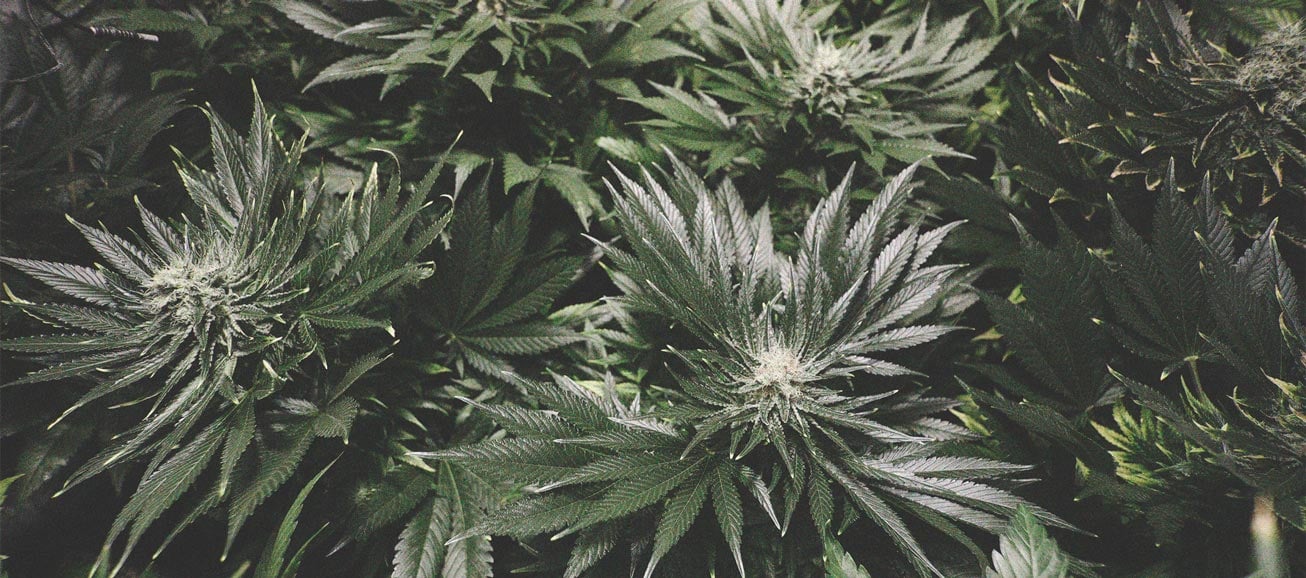
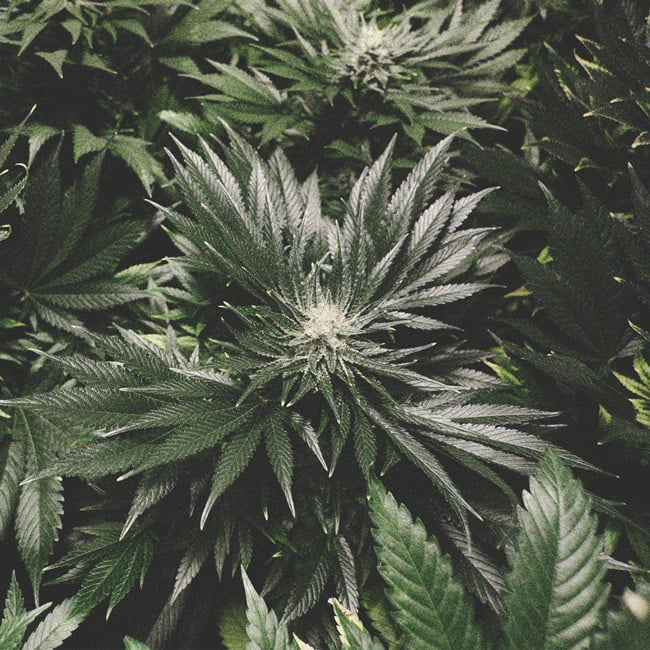
Will Cannabis Plants Recover From Nutrient Burn?
The good news: yes! Well, most of the time. It depends on the severity of your situation. Weed plants exposed to slight nutrient burn over short periods have a good chance of recovering and producing a rewarding yield. However, when left unchecked, nutrient burn has the potential to kill off a plant and eliminate the possibility of a yield altogether.
Keep reading to discover how to fix this issue for the best possible outcome
Identification of Cannabis Nute Burn
Nitrogen is the predominant compound found in cannabis nutrients, especially during the vegetative phase. Nitrogen toxicity will be quickly followed by more severe symptoms.
Early indications of nutrient build-up prior to burning can be:
| Very deep green leaves | Bright, Day-Glow green, almost fluorescent tips | ||||||
| Leaf tips bent at 90° | Stalks and branches will become deep red, magenta, or purple | ||||||
| Sugar leaf and calyx tips will turn yellow, then dieback. Unlike the appropriate dieback of leaves during flowering, overfed bud leaves will remain engorged while they yellow, then dieback quickly and crisply | |||||||
|---|---|---|---|---|---|---|---|
| Very deep green leaves |
| Bright, Day-Glow green, almost fluorescent tips |
| Leaf tips bent at 90° |
| Stalks and branches will become deep red, magenta, or purple |
| Sugar leaf and calyx tips will turn yellow, then dieback. Unlike the appropriate dieback of leaves during flowering, overfed bud leaves will remain engorged while they yellow, then dieback quickly and crisply |
Further indications of nutrient burn are yellow, burnt tips on leaves. This will be widespread as over-fertilisation affects the whole plant. Small, burnt tips are common and nothing to worry about. When the yellowing intensifies and advances, however, it is time to take action. Once leaves start to curl and go brown, they are definitely goners.
Nutrient burn can be gradual if the overdose is only slightly stronger. It can also be rapid-appearing, progressing over a few days. The worst-case scenario is a chronic overdose that causes crop-wide yellowing and wilting overnight with leaf curl and lack of turgidity. In this case, if during the vegetative phase, start again. Recovery may be impossible or take longer than restarting completely.
Buds can be affected by nutrient burn as well. During the flowering phase, cannabis changes the way it uses nutrients. The need for nitrogen drops almost to zero while the demand for other compounds like calcium and magnesium increases. An overdose of any kind of additive will cause the same type of burning features.
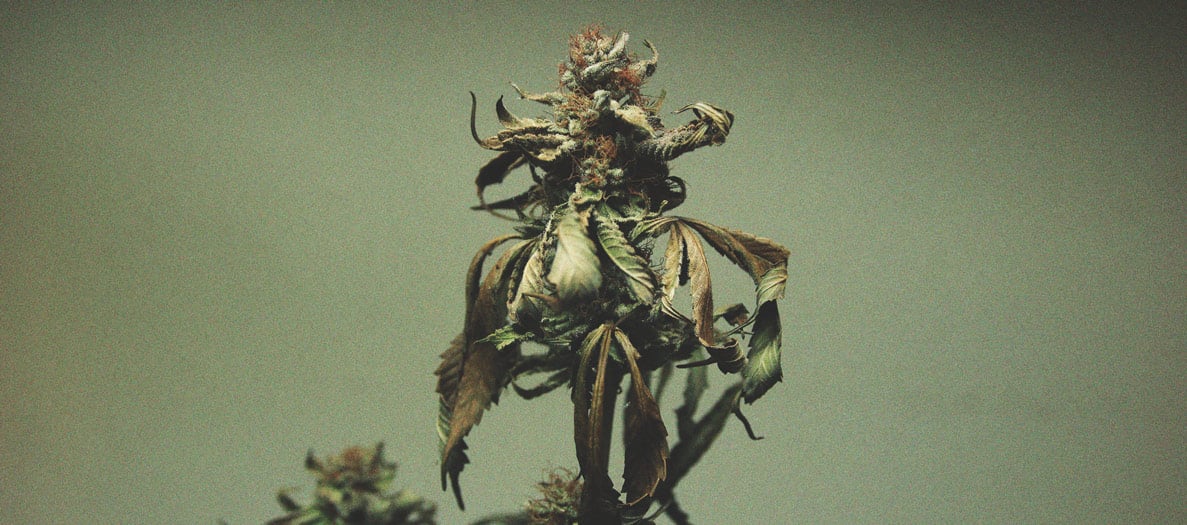
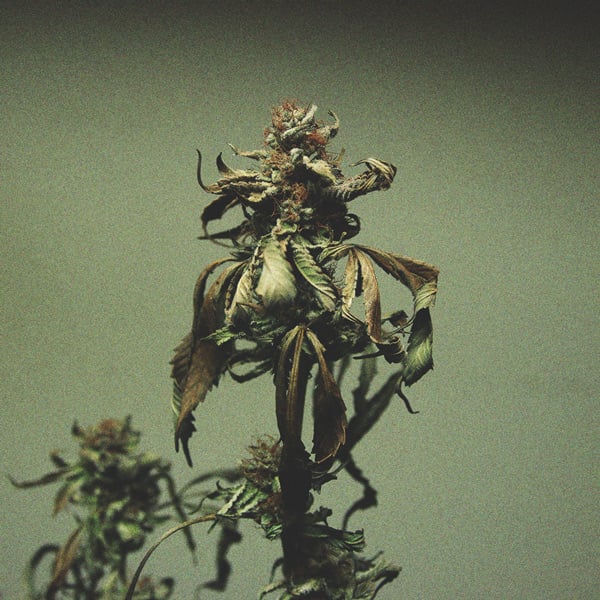
How To Fix Nutrient Burn
Once your plant’s woes have been identified as nutrient burn, carefully remove all the damaged material. Break off all the damaged leaves. Trace calyx clusters back to their branch and remove the whole florette, just to be sure. Dead flowers and leaves will rot. As soon as possible, flush your growing medium out with clean, pH balanced water. If you are growing with a reservoir, measure the contents with a pH/EC meter and adjust with fresh water.
If you are mixing daily by hand, then calm down tiger, less is more with cannabis. Keep in mind that satisfactory results can be obtained with just plain water for the whole life of the plant.
Prior to returning to a regular feeding schedule, use a specialised plant tonic to nurse the plant back to health. The root biosphere will have been affected, as well as the green parts of the plant. Tonics with silver nitrate, humic and fulvic acids, vitamins and minerals are ideal to restore plants to health.
When returning to regular feeding, use only ¾ strength to avoid burning again. Plants will quickly regain their vigour and continue to grow strongly. Remember to adjust the growing period to allow for time lost when the plants were ill. Adding time to the vegetation photoperiod will not harm the plants. If the burning happened during flowering or with autoflowering strains, then you will just have to take the lower yield on the chin.
Hydro Systems
You now know the symptoms, but you’re probably wondering how to fix nutrient burn. Thankfully, hydro growers often have an easier time tackling this plight. Unlike soil growers, they have the advantage of easily swapping out the entire water medium in a matter of minutes. If you notice symptoms of nutrient burn in your hydroponic crop, you can simply empty out the reservoir and replace the solution with a preparation containing less nutrients and an ideal pH level.
Recording the exact amount of nutrients you use in your preparations comes in handy here. Check how much you used when your plants first experienced nute burn, and start by administering half that amount. You should notice an immediate positive change in your plants. Once you dial in your nutrient values, the symptoms of nutrient burn will stop spreading almost right away. The affected leaves won’t recover, but you’ll save the rest of the healthy tissue on your plant.
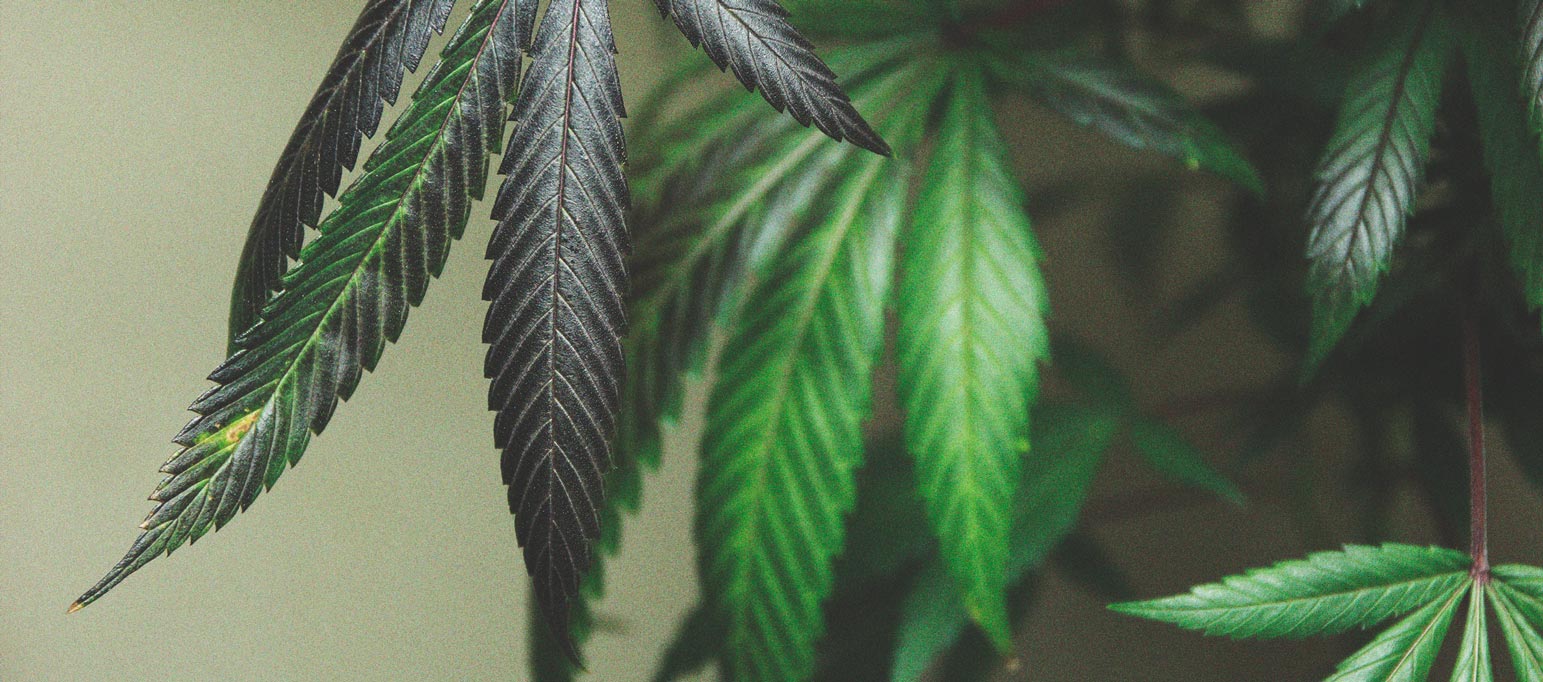
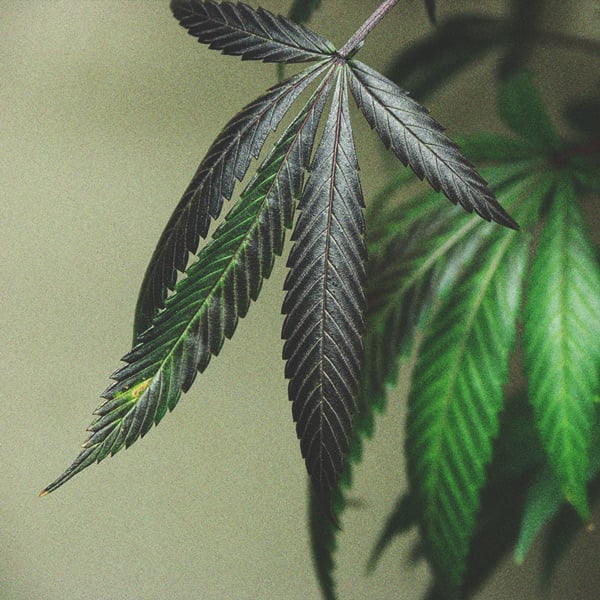
Nutrient Burn Prevention
Prevention is always the best policy, so it is a bright idea to develop good habits that decrease the chances of mistakes. First of all, be sure to use the correct nutrients for the appropriate growth stage. Even then, it is a wise idea to only use ¾ the recommended dosage on product packaging. Sometimes, manufacturer recommendations can run things a bit “hot,” which leaves little room for error.
Check out some of the best techniques to reduce the risk of nutrient burn below.
Use Feeding Charts
Different cannabis plants react to the same amount of nutrients in different ways. It takes some experimentation to find out how certain cultivars respond. As a rule of thumb, consider the recommended dose on nutrient charts as the maximum amount. If your plants are prone to nutrient burn, start out much lower. Using 50% to begin with will help you to avoid burning your plants.
Use Cannabis-Specific Nutrients
Make sure you’re using nutrients that are designed for cannabis. These are tailored specifically to the species, and many products are even designed to support specific periods of the growing cycle.
Consider the Different Needs During Veg and Flowering
Cannabis plants have different nutritional demands as the growing cycle progresses. They prefer higher levels of nitrogen during the vegetative phase to help them develop luscious fan leaves, whereas they prefer higher levels of phosphorus and potassium during flowering. If you dump a load of nitrogen in there during bloom, you can expect to see symptoms of nutrient burn emerge.
Monitor PPM
You can prevent nutrient burn by keeping tabs on the parts per million (PPM) and electrical conductivity (EC) readings of your hand-mixed nutrient solutions and runoff. Both of these values offer an indication of the amount of nutrients present in your nutrient preparations and growing medium.
Below, you’ll find a brief reference of what these figures should look like during the main phases of growth in different growing media. Runoff readings that are too high point to a buildup of salts and an increased risk of nutrient burn.
| Soil | Hydro | |
| Seedling | 350–400ppm | EC (mS/cm) 0.7–0.8 | 400–500ppm | EC (mS/cm) 0.8–1 |
| Vegetative | 500–750ppm | EC 1.0–1.5 | 600–850ppm | EC 1.2–1.7 |
| Flowering | 750–900ppm | EC 1.5–1.8 | 850–1100ppm | EC 1.7–2.2 |
*PPM 500 scale used
| Soil | Hydro | |
| Seedling | 350–400ppm | EC (mS/cm) 0.7–0.8 | 400–500ppm | EC (mS/cm) 0.8–1 |
| Vegetative | 500–750ppm EC 1.0–1.5 |
600–850ppm EC 1.2–1.7 |
| Flowering | 750–900ppm EC 1.5–1.8 |
850–1100ppm EC 1.7–2.2 |
*PPM 500 scale used
How To Measure PPM and EC
To measure ppm, you’ll need a total dissolved solids (TDS) meter. Calibrate your device, make sure it reads zero, and place it into the solution you want to test. To measure EC, you’ll need to add a conductivity tester to your toolkit. These devices allow you to measure the salinity of your solution at the click of a button, which will help you to avoid excess salt levels.
Use an EC/pH meter to check nutrient strength every time, whether hand mixing daily or in hydro reservoirs. Be sure to flush hydroponic systems, grow mediums, and soils to prevent salt build-up in the root zone.
If you’re growing cannabis using hydroponics, you can reduce the concentration of nutrients you administer. This will help you move toward a sweet spot while reducing the risk of further nutrient burn. You don’t have to stick to the manufacturer’s recommendations; go ahead and over-dilute your solution to suit the needs of your plants.
When measuring nutrients, use a measuring device that has a set capacity. If the mix is 10ml per litre, use a 10ml kitchen-type measuring spoon, for example. Take the human error out of the equation as much as possible. It is very easy to overdose if you misread a measuring line on a jug or cup. Looking down on a measuring line will always be too much. Make sure you always measure at eye level.
A Word on Organic Soil
One of the numerous benefits of growing in organic soil is that it provides a buffer zone of organisms around the root system. Soil grown plants are more resilient to overfeeding and other stressors. A well-prepared organic soil really needs no nutrients for the entire grow cycle, removing the danger of burning altogether.
Don't Mistake Other Issues for Nutrient Burn
Several conditions cause cannabis plants to develop symptoms similar to those of nutrient burn. Remember, the key symptoms of nutrient burn include:
| Yellow or brown leaf tips | Ends of leaves become crispy and twisted | Discolouration starts to spread up the leaf |
| Irregular spots and marking | Curling and clawing leaves |
| Yellow or brown leaf tips | Ends of leaves become crispy and twisted | ||||||
| Irregular spots and marking | Curling and clawing leaves | ||||||
| Discolouration starts to spread up the leaf | |||||||
|---|---|---|---|---|---|---|---|
The causes of nutrient burn include:
| Excess nutrients in poorly rotted manure, or overly concentrated synthetic applications | |||||||
|---|---|---|---|---|---|---|---|
| Dry soil | Low levels of light | ||||||
| Excess nutrients in poorly rotted manure, or overly concentrated synthetic applications | |||||||
|---|---|---|---|---|---|---|---|
| Dry soil | Low levels of light | ||||||
Some nutritional deficiencies and toxicities can take on the appearance of nutrient burn, so you need to know how to differentiate between them to ensure you’re treating the right one.
Nutrient Burn vs Nitrogen Toxicity
Cannabis plants depend heavily on nitrogen. This essential macronutrient serves as a key component of amino acids and enzymes. However, overfeeding cannabis with nitrogen can cause big problems. Nitrogen toxicity shares some key symptoms with nutrient burn, including:
| Brown and yellow leaf tips | Curling and clawing leaves |
| Brown and yellow leaf tips | Curling and clawing leaves |
However, the symptoms that set nitrogen toxicity aside from nutrient burn are:
| Dark leaves | Shiny or smooth leaves | Completely yellow leaves |
| Dark leaves | Shiny or smooth leaves | ||||||
| Completely yellow leaves | |||||||
|---|---|---|---|---|---|---|---|
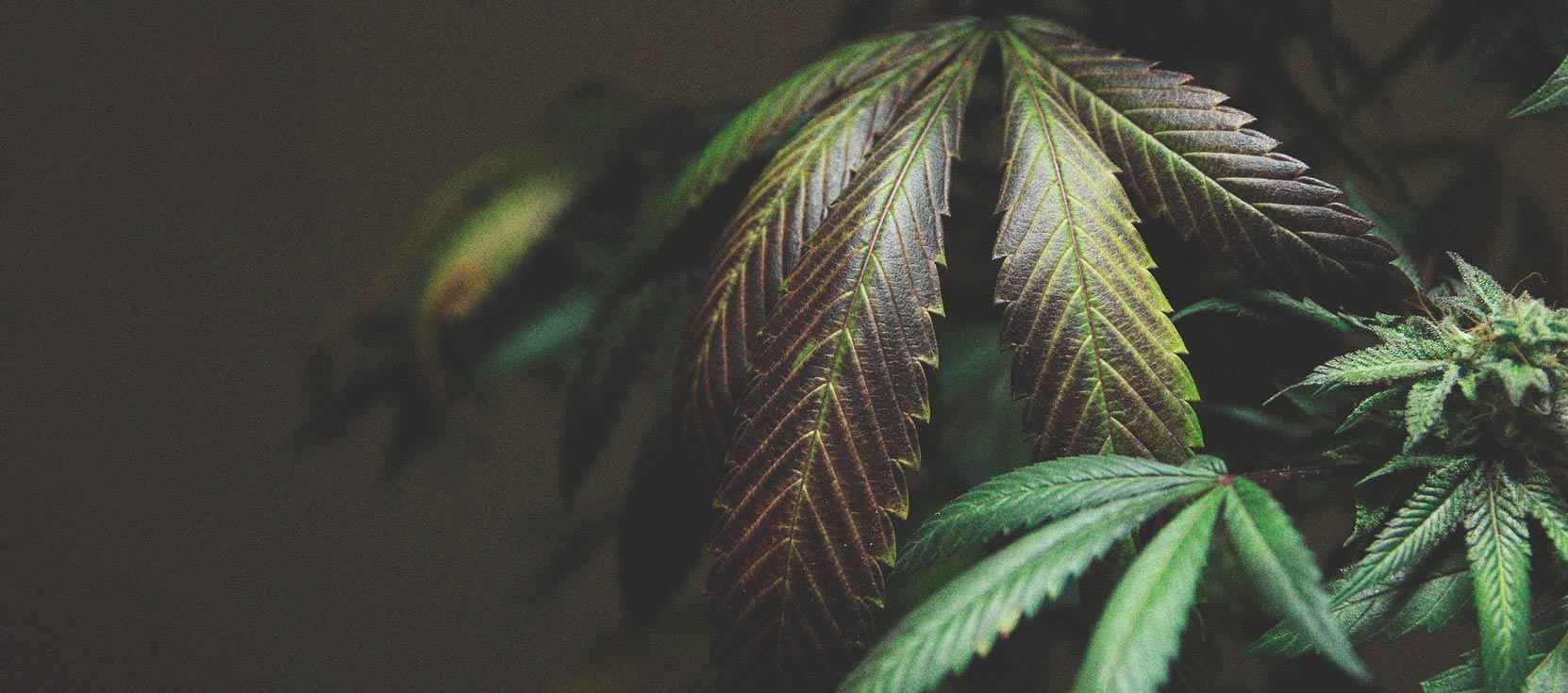
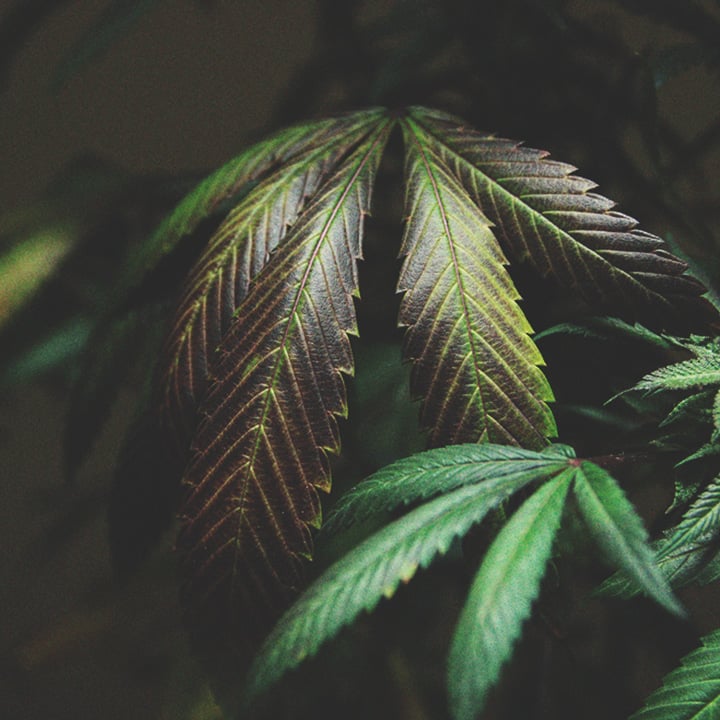
Nutrient Burn vs Nutrient Deficiency
Nitrogen deficiency sets in when a cannabis plant doesn’t have enough access to this key nutrient. Luckily, the symptoms of this issue don’t look like nutrient burn, instead manifesting as:
| Wilting leaves | Completely yellow leaves |
| Wilting leaves | Completely yellow leaves |
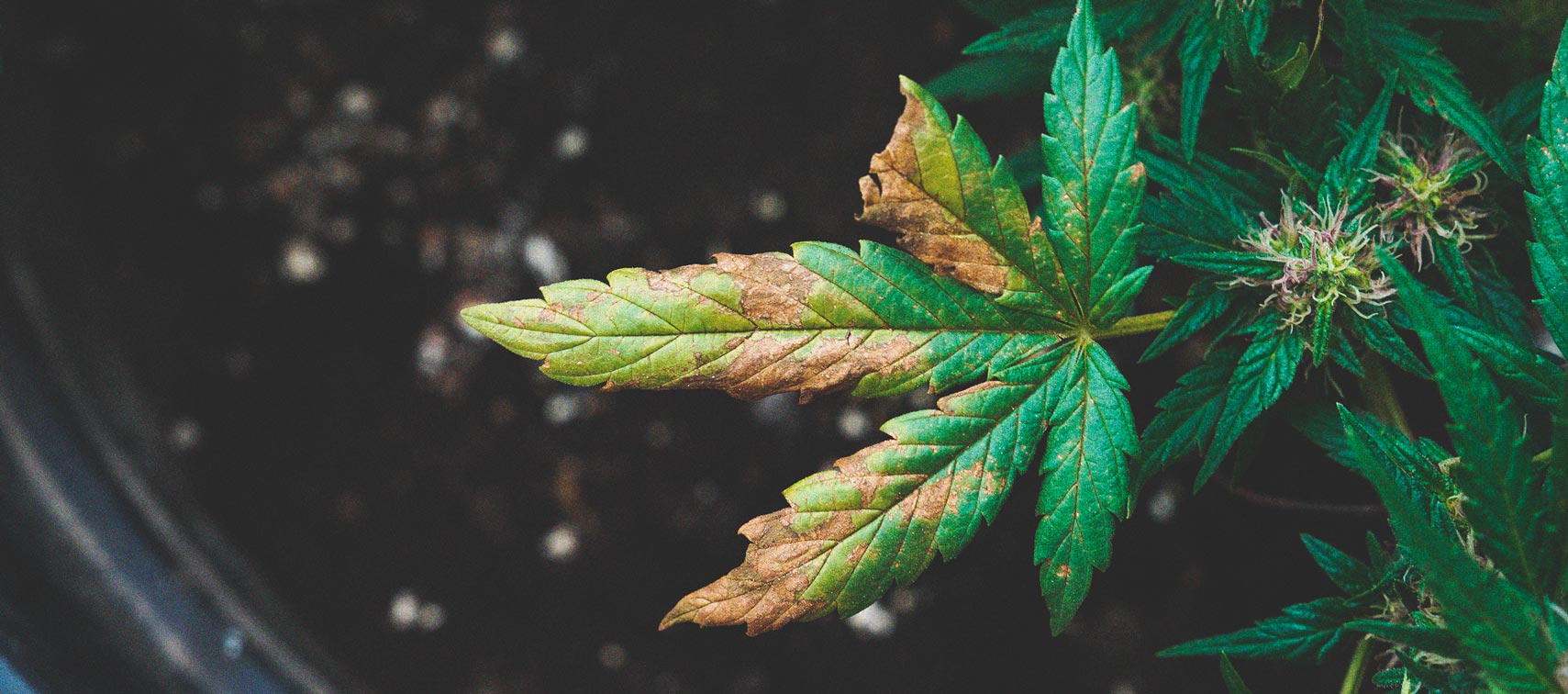
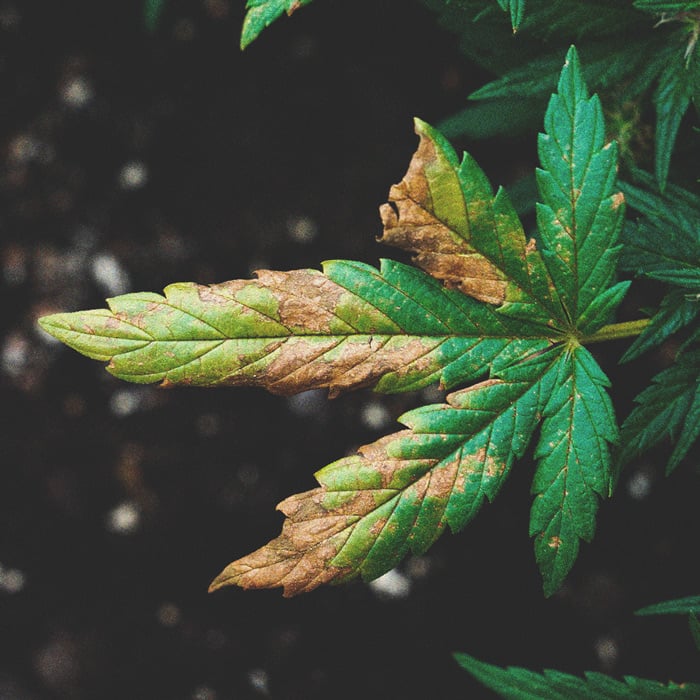
Nutrient Burn vs Overwatering (or Underwatering)
Even too much (or too little) water can cause some serious damage to your cannabis crop. Overwatered and underwatered plants share some symptoms with nutrient burn, including:
| Curling or clawing leaves | Spots or markings |
| Curling or clawing leaves | Spots or markings |
But the symptoms that make it easy to tell them apart are:
| Drooping plant | Wilting leaves | Completely yellow leaves | Bronze patches |
| Drooping plant | Wilting leaves |
| Completely yellow leaves | Bronze patches |
Other clues can help you tell these conditions apart. For example, overwatered plants are subject to a saturated growing medium, whereas underwatered plants have an overly dry medium. Plants with nutrient burn might have slightly dry soil, but they can also have a perfectly moist growing medium and still show symptoms.
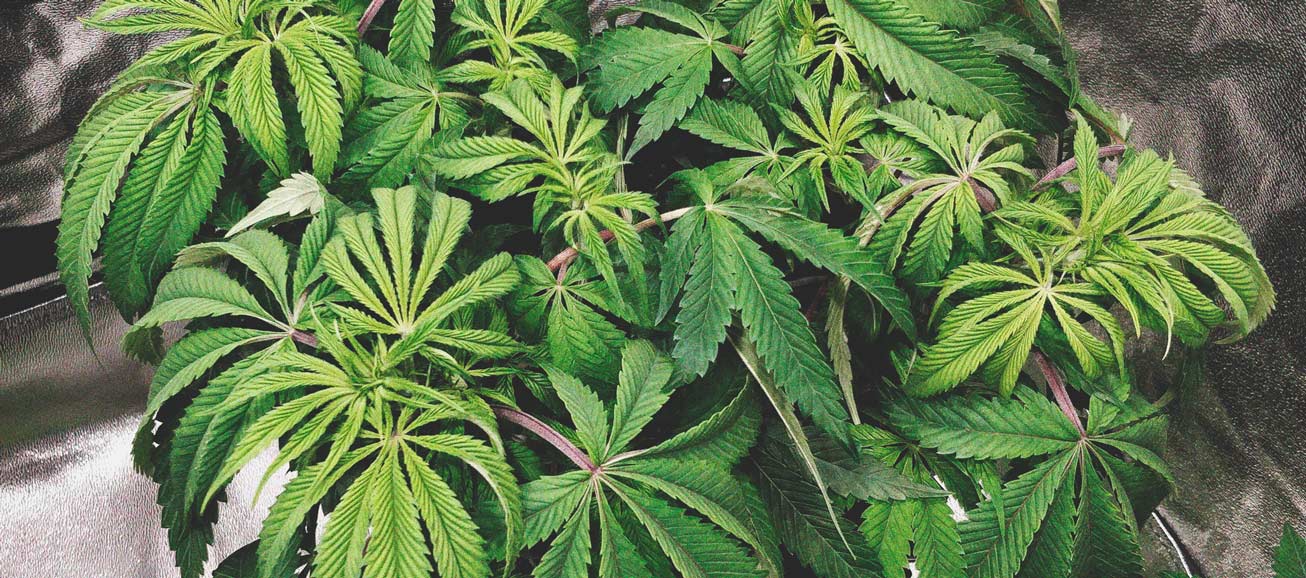
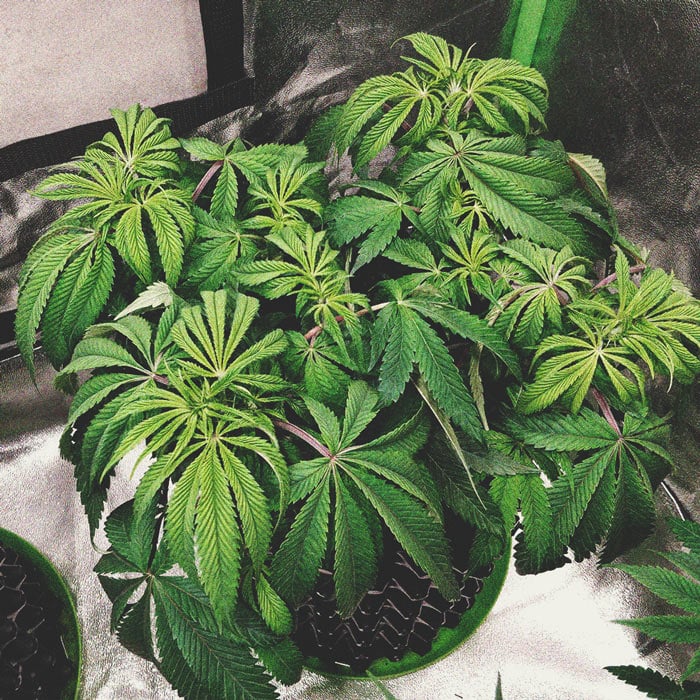
Nutrient Burn vs Heat Stress
Heat stress can occur when the tops of plants are positioned too close to lights or are exposed to heat waves outdoors. Plants undergoing heat stress also display curling and clawing leaves. However, only the leaves closest to the heat source will show these signs in the early stages, whereas abnormal leaves due to nutrient burn can pop up anywhere on the plant.
You’re Now Prepared To Prevent and Treat Nutrient Burn
Congratulations, you’ve just added even more knowledge to your growing arsenal! You now know the best ways to prevent nutrient burn, and how to tackle it if you see the signs. Keep in mind, cannabis plants rely on healthy leaves to photosynthesise and create energy—hence why nutrient burn can cause so much damage.
Also, remember that every cannabis plant is unique. Each variety and individual plant of the same cultivar may respond differently to nutrients. You’ll need to frequently monitor your plants after feeding. If you see signs emerge, dial back on the amount you’re using. If you want to laser in on prevention, put your TDS and EC meters to the test.
Nutrient burn can be a cumulative problem or an overnight disaster depending on the overdose amount. Early detection and remediation can save your crop. Don’t freak out if your plants get burnt; well okay, freak out a little bit. Then, follow these easy steps to return plants to health and vitality.


























